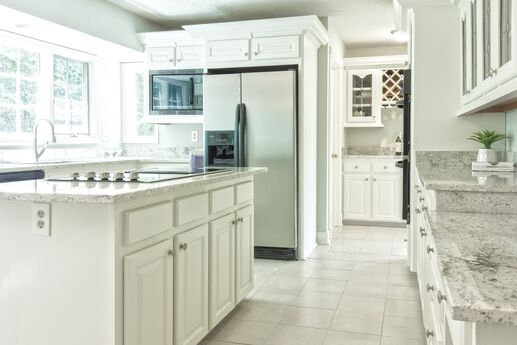
Upgrading your kitchen cabinets can be notoriously expensive. Luckily, your first important decision is free: should you reface or replace them? Here are the pros and cons of each strategy:
Reface
Think of this option as a facelift; you “reskin” your cabinets so they appear new, rather than starting from scratch. You leave the framework alone and just add new doors, drawer faces, hardware and surfaces.
Pros:
It’s half the cost of replacing. A $700 budget can cover many DIY cabinet jobs. Depending on quality, new doors and drawer faces usually run $10-$40 each, and the hardware (handles, knobs and hinges) runs $4-$25 apiece. Veneer materials will run you about $50.
It’s a fairly easy job. Anybody with basic crafting skills can reface in a weekend or two, solo, with little more than an electric screwdriver.
It can yield a dramatic effect. Your kitchen may appear wholly redone.
It’s easy to choose your intensity. You can paint your cabinets and swap in new handles for $50 — or reface every surface with modern Rigid Thermofoil (RTF) items for $2,500. Or pick from something in between.
It’s environmentally friendly. This option means fewer cabinets filling up landfills.
You can use your kitchen during the project. Enough said.
Cons:
Your options are only cosmetic. You can’t make big functional improvements (like adding more storage) or change your kitchen layout.
You need high-quality cabinets. Refacing inferior, rotting or damaged cabinetry is a fool’s errand. If the cabinet “boxes” — or wood casings — won’t give another solid decade of service, it’s better to replace them. Tip: Cabinets made before the early 1980s tend to be higher quality.
Veneering can be tricky. It’s usually the most difficult, time-consuming task in refacing, and getting good results takes practice.
Replace
For this option you’ll be tearing out your old cabinets and installing new ones.
Pros:
The sky’s the limit. You can change your kitchen layout however the room dimensions allow. You can double (or halve) your storage, move cabinets to the opposite wall, use custom-sized components, relocate major appliances, etc.
You get down to bare walls. This aids plumbing, electrical or wall renovations.
Cabinets get strong, new boxes. No worries about aging framework.
You can plan for future upgrades. New cabinets can start looking outdated in just a couple of years, so planning for easy refacing can save you big later on.
Cons:
Cost. The Benjamins will fly when you replace cabinets. Expect to spend $2,000-$4,000 for DIY, and at least $10,000 if you hire a professional installer.
It’s an advanced DIY project, both in terms of skill and time — even if you’re using stock, ready-to-assemble (RTA) cabinets. You’re looking at five, eight-hour days, minimum, for a modest-sized kitchen. And you’ll need a helper.
It’s easy to make expensive errors. It’s critical to measure multiple times, make accurate sketches and take product directions seriously. Buy a good level, a plumb and chalk line.
You’ll need to dispose of the old cabinets. Sell or give them away on Craigslist.com; unless they’re broken or rotten, they’re probably still usable.
Your kitchen will be unusable during the project. Enough said.
For either approach, take these steps to get started.
- Research your materials. Avoid poor quality pressboard or particle-board. Opt for solid wood, plywood or 3/4 inch medium-density fiberboard (MDF).
- Look for used stuff. People toss out perfectly good cabinets every day. Check “architectural salvage yards” for deals on wood boxes.
- Be certain before you buy. Restocking fees at home supply centers can run 25 percent or more.
